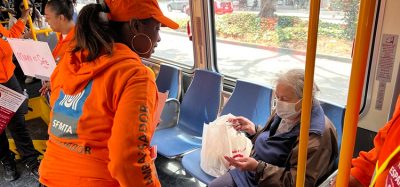CCTV and video analytics for public transport
- Like
- Digg
- Del
- Tumblr
- VKontakte
- Buffer
- Love This
- Odnoklassniki
- Meneame
- Blogger
- Amazon
- Yahoo Mail
- Gmail
- AOL
- Newsvine
- HackerNews
- Evernote
- MySpace
- Mail.ru
- Viadeo
- Line
- Comments
- Yummly
- SMS
- Viber
- Telegram
- Subscribe
- Skype
- Facebook Messenger
- Kakao
- LiveJournal
- Yammer
- Edgar
- Fintel
- Mix
- Instapaper
- Copy Link
Posted: 9 August 2007 | Peter Fry, Head of CCTV Users Group | No comments yet
It is only weeks since the attempted bombings in London and Glasgow, and I cannot forget my group’s frantic activity as they were involved in supplying CCTV footage. Images of the events following the attacks in July 2005 – and being able to track and identify the suicide bombers – highlight just one important role CCTV plays throughout the UK.
Beyond any doubt, those incidents showed the critical importance that well managed CCTV systems can have in providing incontrovertible evidence. They also provided good quality images that helped the Police and courts bring the perpetrators to justice. These images came not only from town and city centre systems but from all facets of the public transport system; from London’s underground, buses, train stations, and now in the latest attacks the airport systems.
It is only weeks since the attempted bombings in London and Glasgow, and I cannot forget my group’s frantic activity as they were involved in supplying CCTV footage. Images of the events following the attacks in July 2005 – and being able to track and identify the suicide bombers – highlight just one important role CCTV plays throughout the UK. Beyond any doubt, those incidents showed the critical importance that well managed CCTV systems can have in providing incontrovertible evidence. They also provided good quality images that helped the Police and courts bring the perpetrators to justice. These images came not only from town and city centre systems but from all facets of the public transport system; from London’s underground, buses, train stations, and now in the latest attacks the airport systems.
It is only weeks since the attempted bombings in London and Glasgow, and I cannot forget my group’s frantic activity as they were involved in supplying CCTV footage. Images of the events following the attacks in July 2005 – and being able to track and identify the suicide bombers – highlight just one important role CCTV plays throughout the UK.
Beyond any doubt, those incidents showed the critical importance that well managed CCTV systems can have in providing incontrovertible evidence. They also provided good quality images that helped the Police and courts bring the perpetrators to justice. These images came not only from town and city centre systems but from all facets of the public transport system; from London’s underground, buses, train stations, and now in the latest attacks the airport systems.
Public transport obviously has an important role throughout the UK, both for the innocent customers of their services and the ardent terrorist who might use them as a target for their nefarious actions. With CCTV in bus and train stations, ports and airports, on trains, the underground, buses and taxis, CCTV systems in public transport provides a unique and undeniable function in combating the terrorist threat now facing us.
But these systems must be well managed and fit for the purpose intended. In truth, very few CCTV systems were fitted with the principal objective of deterring terrorism. The majority of public transport systems were installed with the intention of improving the safety of customers and staff. A very worthy aim, but if the original operational requirements of the system are re-examined, you might find that a different system is required to meet your needs.
Possibly more thought might have gone into camera locations to ensure high quality, identification sized images are obtainable, rather than a general area overview. Possibly more thought might have gone into the value of the highest quality historical recording, rather than too many cameras on one multiplexer; or the recorder operating in 24-hour rather than 12-hour mode, resulting in low frame rates that missed most of the action.
Despite digital recording systems, these problems aren’t exactly eradicated. The July 2005 events showed that the Police and their video analysts had far more problems with the digital systems than they ever did with analogue recordings. Previously, it was so easy to send a PC to seize the tapes, put them onto a review suite and play them through. But now, with the increasing popularity of digital technology and the massive variety of equipment available, they need to be technical specialists to view the different formats and protocols involved. And even that relies on them being able to download the images to a portable media device in order to access and store the images. In 2005, the Police found systems that had no means of downloading to any other media; no floppy disk drive, no CD or DVD drive, no USB Port, and no Ethernet port. The only course of action available was to seize the hard drive.
Despite what many may think, digital recording is not a magical solution. In fact, it poses dilemmas that were common in the old analogue days. There is the ever present trade off between image quality and recording rate. Of course, digital technology enables images to be recorded for historical purposes at a much higher rate than the one second refresh rate for multiplexed tape records. Many systems are now storing these historical records at anything between three and 25 frames per second. It’s fair to say that the higher the rate, the more value the recording has. But it’s often only achieved by reducing the resolution of the image; and for post-event analysis, image resolution is critical. When watching over car-parks, a typical overview using a 640 x 480 pixel (approximately 300,000 pixels) CCD imager will provide what appears to be a good image on a monitor. However, if a part of the picture is enlarged by just five times, pixilation reduces the quality to the extent that any positive identification is almost impossible. In essence, CCTV is superfluous if it isn’t working properly or is not fit for purpose.
Digital technology has also spawned a new industry sector which many are now saying will be the principal area of CCTV growth in the next decade. Video Analytics is harnessing the power of the computer to analyse the image rather than merely show it on a monitor. Much of the current research and development has been to use this technology to bring potential incidents that may be of interest to the operator.
Possibly one of the first developments in this field was Automatic Number Plate Recognition (ANPR). Now in use throughout the UK for a wide variety of purposes – including the London Congestion Charge, average speed checks through road works, as well as crime detection and investigation – it has proved a major innovation with a high degree of reliability.
In its simplest form, the cameras are set to focus on the number plate. The software reads this and compares it with registration numbers held in a computer database. If it finds a match, it will identify the vehicle appropriately. In contrast, average speed cameras record the registration number of each vehicle entering and leaving a section of road works, as well as the precise time. The computer then calculates the average speed over the known distance and, by using the DVLA database, sends out penalty notices to vehicle owners who exceed the defined speed. The potential uses of this well-proven technology are limited only by the imagination, and new innovative uses will continue to be developed.
Facial recognition systems can analyse aspects of a person’s face and compare specific measurements with those from images stored within its own database. Despite the ambitious hopes expressed following its launch, use in early trials for public space surveillance had limited success as it was not practical to control all the environmental aspects. This is necessary, in order to ensure that images are comparable with those on the database.
The growth in the research and development of Video Analytics appears to have recently expanded, especially following the July 2005 terrorist attacks. They work by bringing ‘abnormal’ events to the attention of the operator. Many are based upon specific behavioural algorithms built into the control software, but others rely upon the camera learning the normal view, and triggering an alarm if the image changes.
Typical uses are corridors where pedestrian flow is normally in one direction, so the system alerts operators if movement occurs in the opposite direction, or if a stationary object (for example a bag or case) appears. In a similar application, it can even be utilised on motorways because the camera learns that there is seldom movement on the hard shoulders and central reservation. Again an alarm will occur if the parameters of this normal view are breached.
However, equally interesting is the research going into abnormal behaviour recognition. A number of universities are working in partnership with CCTV companies to examine gun crime, assault, and even suicide bombers, in a bid to identify the behaviour traits and predict incidents before they occur.
As well as this, Video Analytics intends to automate some of the time intensive work and relieve the operator of needing to search hours of tapes or digital recordings for one elusive image. Following London’s terrorist attacks on 7 July 2005, the Police seized nearly 100,000 tapes and digital recordings. All of these needed to be viewed so that the appropriate image could be located but it is widely believed that Video Analytics could hold the key to faster searches. Although some digital systems already have useful search facilities, academics consider a lot more could be achieved by adding metadata to the video stream. By describing the contents of the image, it could be easily indexed and searched for.
With the current level of investment in research, it seems that the heyday of Video Analytics may not be too far away, and this could mean a new future for the use of intelligence lead CCTV. In the last issue of our magazine, CCTVImage, (online at www.cctvimage.com), we devoted eight pages to summarise the experts view of the potential of video analytics. The next CCTV User Group Conference on 1, 2, and 3 October at Bristol will also be exploring this subject and other critical topics in far more detail. If you are a member of the Group I look forward to seeing you there.
Related topics
Security & Crime
Issue
Issue 4 2007
Related organisations
CCTV Users Group
Related people
Peter Fry







